Apologies for the delay in posting April news
Wednesday, May 15, 2013
A new laptop and loading all my files has delayed the
publication of April news so this is a Late Spring edition. Late in
both senses! the weather has been very challenging and it was a
disappointing April with a string of frosts then 2 weeks of drought
before the rains came - just in time for my newly sown grass seed
(more in Garden Update). We still have some daffodils in bloom in
spite of 2 warm days last week, and as my neighbour Meirion used to
say, the better weather won't come until we see the back of those
yellow buggers!! How right he was. (although the poeticus type now
in flower are white with a tiny orange eye and rather nice)
The Paddock Garden lawn last week looking a lot better
than it did 7 weeks ago ( see March news), Close inspection will
however reveal quite a few bare patches but they are filling
fast.
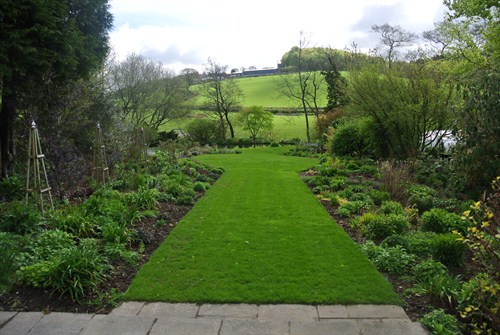
Weather
Cold, windy, dry, sometimes sunny, and latterly very wet it has
not been good growing weather but just a few warmer days in early
May brought on growth so that at last the trees are coming into
leaf, some of them a month later than normal. If it means anything
the oak is before the ash which in old folklore was said to predict
a good summer - we shall see!
11 frosts in April minimum temperature -6C; max 17. So far in
May 2 frosts and our warmest day of the year at 23C on 7 May. We
need a lot more of this if the gardening year is to catch up
Garden update
The lawns have been a concern following the major make over in
late March. It took nearly 4 weeks for the topdressed seed to
germinate but at last the greening up process has begun. With our
first visitors due in early June there is a lot of growing still to
be done.
Vegetable sowing has been slow because I was determined not to
make the mistake of last year by sowing too soon so my first seeds
in the ground were carrots and beetroots on 28 April. Potatoes have
only just started to appear but early cabbages, broccoli and
cauliflowers under horticulutural fleece are undaunted by the
weather.
The usual manic activity in the nursery - always some pricking
out and potting on to be done and late sowings of winter brassicas
and tender vegetables to be made. We are really on top of the
nursery because there have been many days when it has been
unsuitable to work on the beds and borders. The polytunnels and
frames are bursting as it has been too cold to move many plants
outside.
The packed benches in the propagation tunnel, the last
of over 300 varieties of seed sown this year
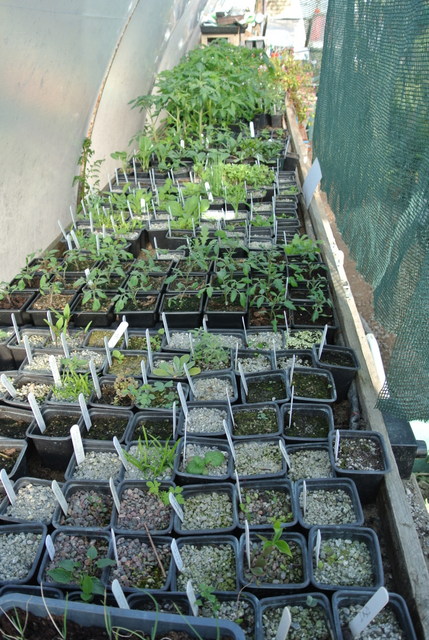
It has been difficult to find a suitable compost (now called
growing media) for seed sowing and small seedlings so I have
started to make my own again. There is considerable debate about
the use of peat in horticulture but believe me when you want
reliability, ease of watering and good growth there is nothing to
touch it. I have recently been making my compost mix based on peat,
sterilised top soil and grit/sharp sand (the old fashioned John
Innes formula). Growth patterns are a big improvement - some of the
composts I was using earlier in the year were quite frankly
rubbish. You opened the bag and the smell was often disgusting,
much of the make up of the bag being shredded wood or still
composting green manures.
The major yearly task of weeding, feeding and tidying all the
flower borders was completed during April - it takes me in excess
of 2 weeks to do this but the effort is worthwhile. I am one of
those nuts that actually enjoys weeding usually with a hand fork
and on my knees:they tell me at night that I shouldn't be doing
this at my time of life! However it gives me the chance to
inspect the condition of emerging plants and to note where division
or re-planting may be necessary.
What's looking good?
The cool spring has been welcomed by many early flowering
plants. A star performer has been the erythoniums (dogs tooth
violets/trout lilies) of which we have several large clumps. In
warm springs they are here and gone in about 10 days but they have
continued to flower for nearly a month this year.
A large clump of erythronium "Pagoda" probably 15 years
old, with narcissus poeticus in the background and one of the last
hellebores

It has been the year of the wood anemone in the woods and
hedgerows. A member of the buttercup family they appreciate cool
moist conditions, and those in the garden have done just as well
and are still flowering strongly. Pulmonarias too have flowered for
longer than normal making a pleasing planting combination with the
anemones which share a similar environment.
Anemone nemerosa "Vestal" with pulmonaria "Lewis
Palmer"

There are good clematis in the Atragene Section
(particularly alpinas, macropetallas and Koreana group). Many of
these I have grown from seed from The British Clematis Society
distribution. You have to be patient and some of those now
flowering well for the first time were sown in 2007! I have had
some very good unusual forms from seed labelled " Koreana mixed" ,
mostly in the pink / white spectrum including some doubles. Strange
that at Malvern Spring Show last week there didn't appear to be any
atragenes for sale - most were forced early large flowered group
looking a little out of place on a raw, dank day!
The plant grown from Koreana mixed seed. Still
only 3 feet tall after 6 years!
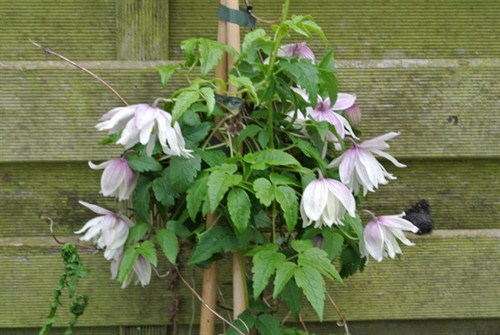
The only spring flowering clematis on show at
Malvern last week courtesy of The British Clematis Society. The
plant societies section is for me one of the best parts of the show
and where you can always rely on sound advice

Hostas have been very slow even those like "Chinese Sunrise"
which is usually the first into leaf in mid March. They are at last
moving, some more so than others depending on their progeny and
locality in the garden. One that has absolutely blown me away in
the last week is "Liberty" a large form which was the American
Hosta Society's hosta of the year in 2012 and you can see why.
LIBERTY!! - only 3 years in the ground from a single pip
and already making a massive statement
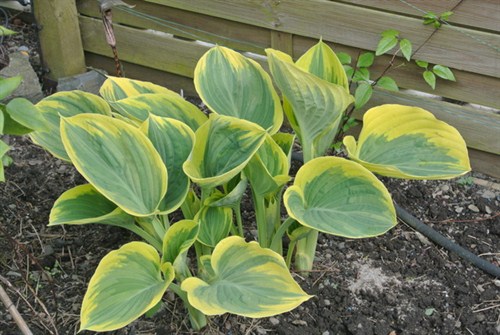
Although we have very few rhododendrons and azaleas in the
garden, there are a couple of dwarf azaleas around the small pond
by the house and they are currently lighting up the front entrance
to the house with a staggering blaze of colour.
The dwarf azaleas and rhododendrons with the
conservatory in the background enjoying its first
birthday!

In the protection of the tunnels there is good colour too from
dwarf Princess alstroemerias, zantedeschias, pelargoniums, and a
few shrubs in pots notably indigofera pendula, quite a sight at
over 6 feet tall, and yellow flowered cestrum parquii. The tunnels
are a nice place to be on a cold wet day.
Indigofera pendula in a pot in the large tunnel.
Possibly reasonably hardy in a choice location outside but better
with winter protection. Flowers all summer when it can be moved
outside
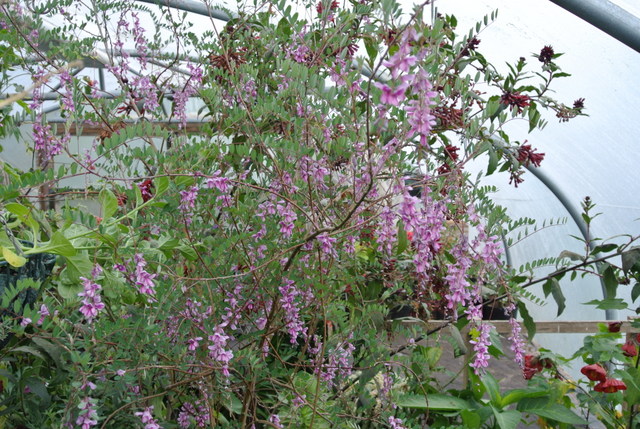
Cestrum parquii - definitely not hardy it will turn up
its toes much below -3C so definitely one for winter protection.
Foetid leaves and mildly scented flowers like many in this genus.
Try cestrum nocturnum if you want overpowering scent on a hot
summers night. Tiny flowers , massive impact but sickly
sweet.
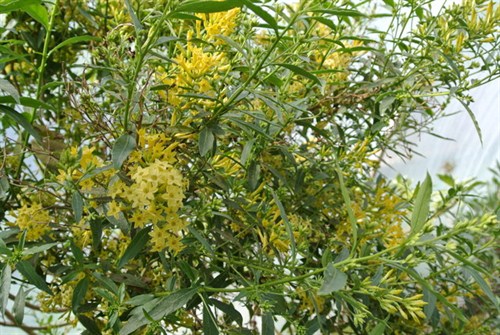
So many other wonderful plants too numerous to name but some
pics to show some of the very best.
Lysichiton camtschchatsensis, smaller than L. americanus
the more commonly encountered skunk cabbage. The white form is much
smaller and has pleasantly fragrant flowers but is slower to become
established. This plant is 4 years old but still quite
small
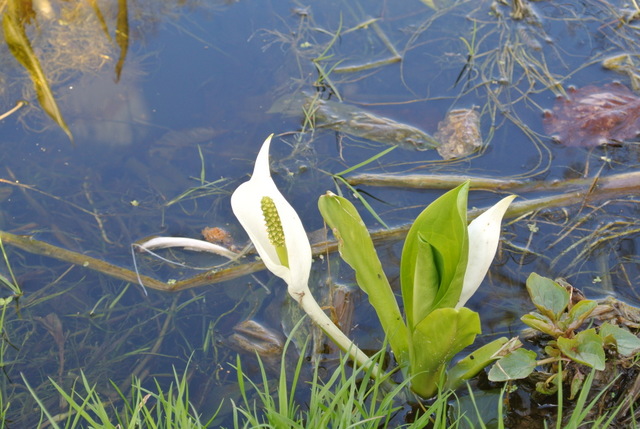
The huge leaves of rheum palmatum atrosanguineum which
will gradually turn green before sending up a white flower spike
over 7 feet tall.
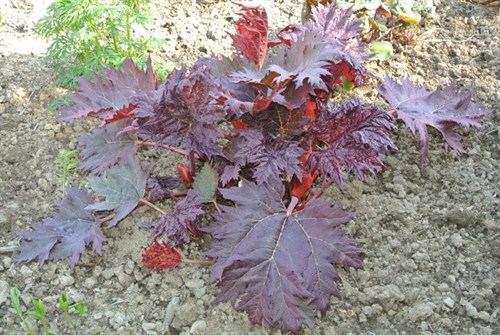
And one of the undoubted highlights of the year is
the first flower on the magical Himalayan blue poppy, meconopsis
sheldonii "Lingholm hybrids" fairly reliably perennial unlike some
others in the group which are decidedly monocarpic.
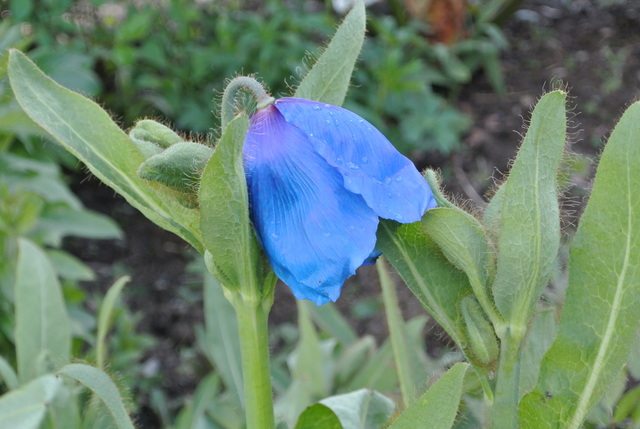
Wildlife and countryside
The first swallows of the year arrived on 15 April - as there
were 2 of them this must be summer!! Moving swiftly on (like that?)
a pair of pied flycatchers have set up home in the nesting box in
the old alder at the back of the Paddock Pond. Back and forward all
day long I guess the eggs have hatched - food comes in and feathers
and other rubbish are brought out. They are bright tidy birds and
as much a harbinger of summer as the swallows in this part of
Wales, one of their strongholds.
Tadpoles have hatched (toads only recently so) but far less than
last year, much of the spawn having been destroyed by the
continuous frosts in March.
Spring wildflowers have been fabulous; primroses, celandines,
wood anemones and latterly wild garlic and bluebells have flowered
in profusion and for longer than usual, bloom times often
overlapping with each other. The anemones however were
exceptional.
rob.i.am (the "pet" robin) has been less in evidence but earlier
this month I found the reason why. He and his beloved have a nest
low down in a shrub in the Paddock Garden, a strange place but the
eggs were all in place so fingers crossed that predators don't find
them.
Visits
The garden talks season drew to a close in April with 2
well received talks in Monmouthshire, one at short notice to The
Hardy Plant Society in Usk, and the other to Chepstow and District
Garden Appreciation Society. Further than we usually go but very
enjoyable with some lively audience participation. For my
local gardening club in Llangadog on 29 May I am having a
"premiere" (no red carpet but a lovely hall and the warmest of
welcomes) to launch a new talk entitled "50 of My Favourite Hardy
Perennials". The talk starts at 7.30 pm in the Community Hall and
all are welcome. Refreshments served after the talk and plants for
sale. Be there!!
We have also visited a couple of gardens one of which Wyndcliffe
Court, St.Arvans, Monmouthshire was very special indeed. Built in
1922 in the Arts and Crafts style it contains all the features one
expects of houses and gardens of this period: beautifully
proportioned house of local dressed stone, garden hard landscaping
(ballustrading, steps, paths and other features) in similar stone,
softened by carefully designed borders and topiary. Although some
of the planting needs refreshing and updating the whole garden has
a massive presence and new custodians who intend to address the
planting considerations once they have settled in. Appropriately
their professions are in arts and crafts and they have a sculpture
exhibition in the gardens this summer which is open to the public
every Friday, Saturday and Sunday until September. For more details
visit their website at www.wyndcliffecourt.co.uk
Two views of Wyndcliffe Court giving a glimpse of some
of the magic of house and garden
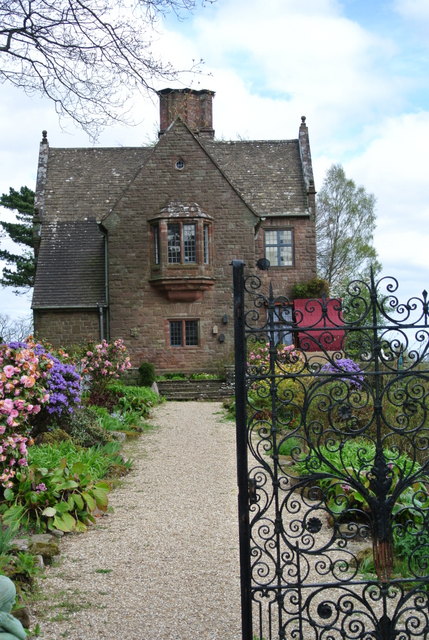

There was also the annual trip to Malvern Spring Gardening Show.
Dry for the most part but cold with a howling gale ir seemed a
rather low key affair with less stalls reflecting perhaps the
economy and late season, but the nurserymen nevertheless had for
sale a wide range of quality plants as always to ease the
money from our pockets!!
My favourite view at the Showground - a row of smaller
nurseries with that superb background of The Malvern Hills the
inspiration of Edward Elgar for much of his music, captured
memorably for all time in his "Introduction and Allegro for
Strings"
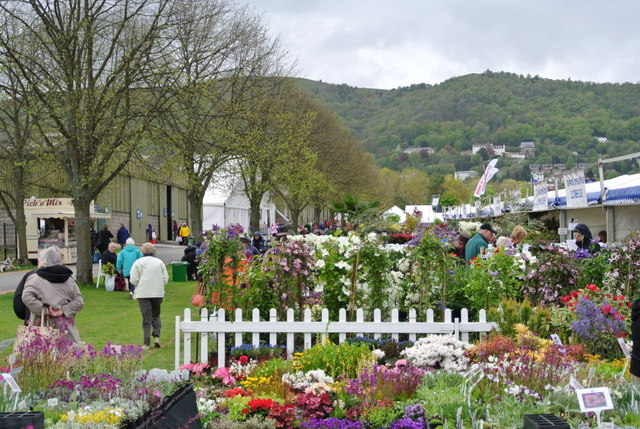
Our own garden visitor season starts on 6 June with Saga
Holidays coming to Cilgwyn which we are much looking forward to and
hope for some better weather and more colour to delight our
visitors.
We still have a couple of spare dates so if you would like to
arrange a group visit between June and September (most dates in
July are now booked) please get in touch. All openings are for The
National Gardens Scheme